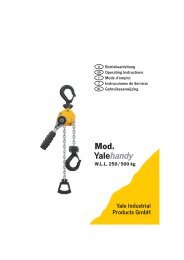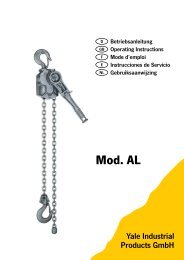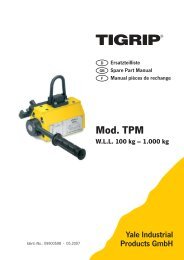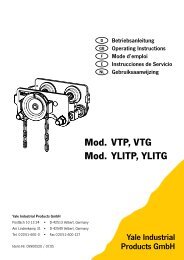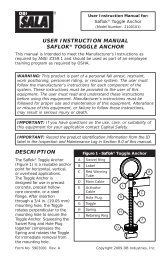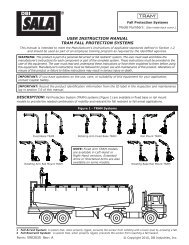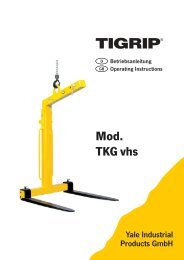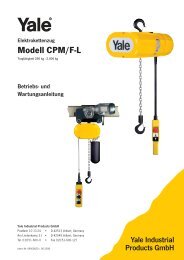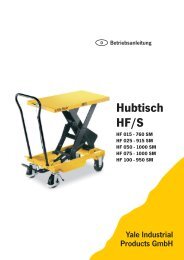blocstop™ BSO - O. Rosinski GmbH
blocstop™ BSO - O. Rosinski GmbH
blocstop™ BSO - O. Rosinski GmbH
Sie wollen auch ein ePaper? Erhöhen Sie die Reichweite Ihrer Titel.
YUMPU macht aus Druck-PDFs automatisch weboptimierte ePaper, die Google liebt.
See Fig. 12.<br />
The independent secondary brake must be mounted in such a<br />
way that the direction (A) in which the rope runs through the<br />
independent secondary brake at the time of the malfunction is<br />
opposite to the braking direction (B).<br />
For independent secondary brakes equipped with a limit switch:<br />
Connection option available in the hoist's control box<br />
Checking the independent secondary brake<br />
and the accessories<br />
Independent secondary brake<br />
– Inspect the housing for signs of damage.<br />
Testing the EMERGENCY-STOP button:<br />
– Trigger the independent secondary brake via the EMER-<br />
GENCY-STOP button.<br />
A clear audible click must be heard when it snaps shut.<br />
Rope<br />
– Check whether the diameter and design of the rope match<br />
the product and the application, see Table 1 on page II,<br />
Table 3 on page 16 and 'Nameplate and warning signs / application<br />
restrictions' on page 6.<br />
– Check that the length of the rope is sufficient:<br />
It must be possible to safely move the load from the start to<br />
the end position.<br />
The independent secondary brake requires a rope end of at<br />
least 3 m.<br />
– Check whether the thimble (1) and sealing cuffs (2) are<br />
undamaged (see Fig. 5).<br />
– Ropes with hooks:<br />
Check that the hook and the safety catch (3) are intact, see<br />
Fig. 5.<br />
– Inspect the entire length of the rope for any signs of damage,<br />
see Fig. 7.<br />
– Inspect the rope tip in accordance with Fig. 9 (see also<br />
'16.3 Care and maintenance, Rope' on page 15).<br />
Anchoring devices<br />
– Check whether the bolts/screws/rigging comply with the<br />
specifications in '4.7 Anchoring' on page 7.<br />
– Inspect the fishplates, load bolts and screw connections for<br />
damage.<br />
10.3 Assembly<br />
Requirements<br />
Assembly may only be performed by trained personnel.<br />
The workplace must have adequate lighting.<br />
The gap between the safety rope and the suspension rope<br />
must be as small as possible.<br />
Installation and operating manual<br />
Position of the securing module:<br />
The gap between the securing module and the independent<br />
secondary brake must be set up so that the rope runs vertically<br />
into the inlet on the independent secondary brake.<br />
Mounting the independent secondary brake<br />
DANGER!<br />
Danger of severe injuries caused by incorrect anchoring!<br />
High-strength, galvanised bolts and screws can become brittle<br />
and break. Risk of falling and of being injured by falling objects!<br />
– High-strength galvanised bolts / screws (10.9 or 12.9)<br />
may not be utilised for anchoring.<br />
– Utilise bolts / screws with the specified strength.<br />
Danger of severe injuries caused by incorrect anchoring!<br />
Risk of falling and of being injured by falling objects!<br />
– Both securing holes must be used to secure a blocstop<br />
<strong>BSO</strong> 2050 or 2360 to the securing module.<br />
– The securing module must be fitted with two fishplates or<br />
similar.<br />
Depending on the application, observe the direction of the force<br />
of the independent secondary brake (see also Fig. 12 and<br />
'4.1 Functional description' on page 6).<br />
– Attaching the independent secondary brake to the securing<br />
module.<br />
<strong>BSO</strong> 500 - <strong>BSO</strong> 1040: 1 bolt or 1 screw<br />
<strong>BSO</strong> 2050 series, <strong>BSO</strong> 2360 series: 2 bolts or 2 screws<br />
– Secure the bolts with a cotter pin or similar lock.<br />
– Use screws with self-locking nuts to stop them from being<br />
lost.<br />
Installing the safety rope<br />
DANGER!<br />
Risk of injury through stabs and cuts!<br />
Broken wires in the wire rope can result in protruding wires!<br />
Protruding wires can cut or stab through safety gloves!<br />
– Wear suitable leather protective gloves when working<br />
with wire ropes.<br />
– Never let the wire rope run through your hands!<br />
Danger of severe injuries caused by incorrect anchoring!<br />
There is a risk of malfunction if the independent secondary<br />
brake cannot align with the rope.<br />
– The independent secondary brake must be secured in<br />
place so that the rope runs vertically into the independent<br />
secondary brake from above.<br />
– The independent secondary brake must be aligned so<br />
that it does not touch the rope.<br />
– The rope must be tensioned using a tensioning weight or<br />
a relevant winding device.<br />
G905.5 - 02/2011 EN-9




